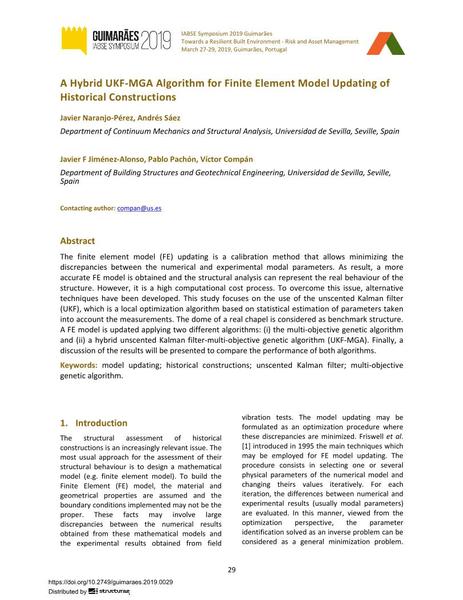A Hybrid UKF-MAG Algorithm for Finite Element Model Updating of Historical Constructions

|
|
|||||||||||
Détails bibliographiques
| Auteur(s): |
Javier Naranjo-Pérez
(Department of Continuum Mechanics and Structural Analysis, Universidad de Sevilla, Seville, Spain)
Andrés Sáez Javier F. Jiménez-Alonso (Department of Building Structures and Geotechnical Engineering, Universidad de Sevilla, Seville, Spain) Pablo Pachón (Department of Building Structures and Geotechnical Engineering, Universidad de Sevilla, Seville, Spain) Víctor Compán (Department of Building Structures and Geotechnical Engineering, Universidad de Sevilla, Seville, Spain) |
||||
|---|---|---|---|---|---|
| Médium: | papier de conférence | ||||
| Langue(s): | anglais | ||||
| Conférence: | IABSE Symposium: Towards a Resilient Built Environment Risk and Asset Management, Guimarães, Portugal, 27-29 March 2019 | ||||
| Publié dans: | IABSE Symposium Guimarães 2019 | ||||
|
|||||
| Page(s): | 29-36 | ||||
| Nombre total de pages (du PDF): | 8 | ||||
| DOI: | 10.2749/guimaraes.2019.0029 | ||||
| Abstrait: |
The finite element model (FE) updating is a calibration method that allows minimizing the discrepancies between the numerical and experimental modal parameters. As result, a more accurate FE model is obtained and the structural analysis can represent the real behaviour of the structure. However, it is a high computational cost process. To overcome this issue, alternative techniques have been developed. This study focuses on the use of the unscented Kalman filter (UKF), which is a local optimization algorithm based on statistical estimation of parameters taken into account the measurements. The dome of a real chapel is considered as benchmark structure. A FE model is updated applying two different algorithms: (i) the multi-objective genetic algorithm and (ii) a hybrid unscented Kalman filter-multi-objective genetic algorithm (UKF-MGA). Finally, a discussion of the results will be presented to compare the performance of both algorithms. |
||||
